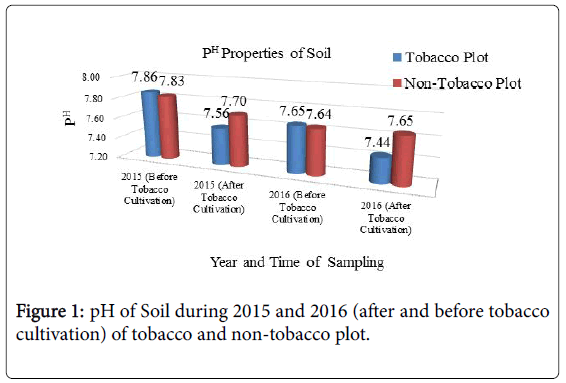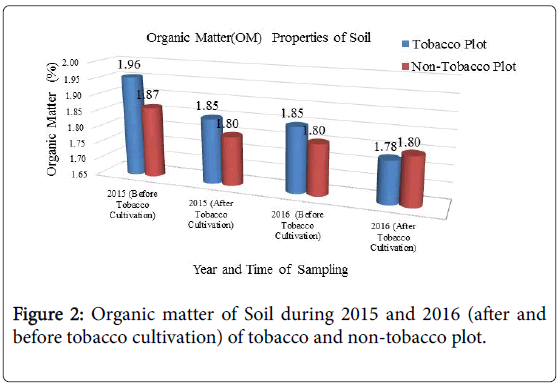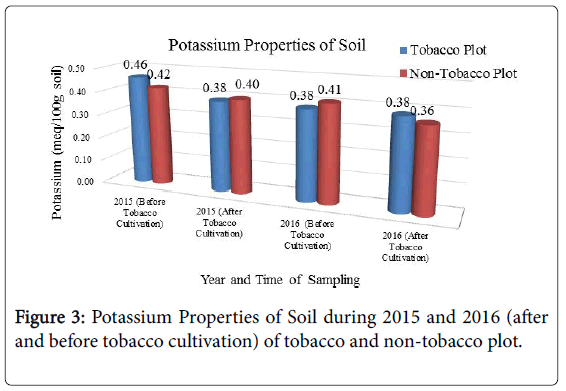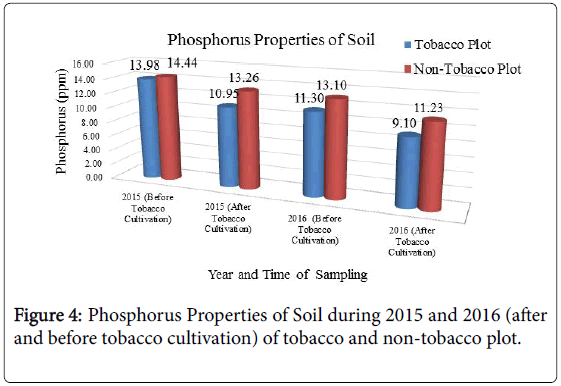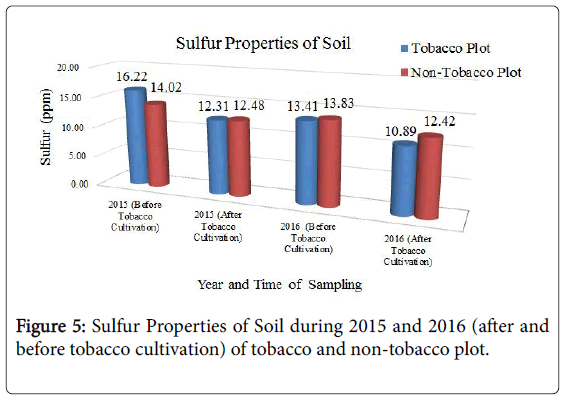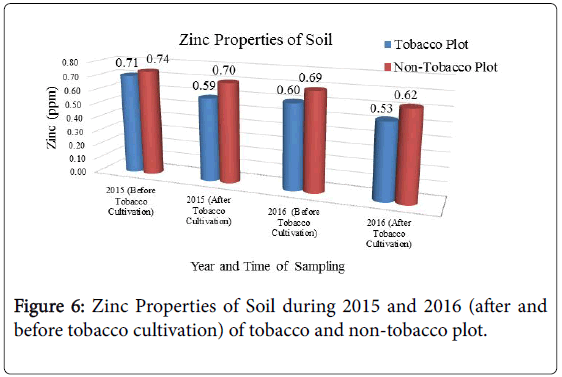Effects of Consecutive Two Years Tobacco Cultivation on Soil Fertility status at Bheramara Upazilla in Kushtia District
Received: 01-Feb-2018 / Accepted Date: 20-Feb-2018 / Published Date: 25-Feb-2018 DOI: 10.4172/2375-4338.1000190
Abstract
The study was conducted to determine the effects of tobacco cultivation on soil fertility and to compare the fertility status of tobacco based cropping patterns growing plot with adjoining non-tobacco based cropping pattern growing plots on randomly selected farmers plots for two consecutive years at Bheramara Upazilla (AEZ 11-High Ganges River floodplain) of Kushtia district by farmers practice, where tobacco farming is popular and on increase and to get a good scenario of soil fertility status of tobacco farming in Bangladesh. However, in tobacco plots, average pH value decreases from 7.86 to 7.44, Organic Matter from 1.95% to 1.78%, K from 0.46 meq/100 g to 0.32 meq/100 g, P from 13.98 ppm to 9.10 ppm, S from 16.22 ppm to 10.89 ppm and Zn from 0.70 ppm to 0.53 ppm after two consecutive years. Whereas, at non-tobacco plots, average pH value decreases from 7.83 to 7.65, Organic Matter from 1.86% to 1.79%, K from 0.42 meq/100 g to 0.36 meq/100 g, P from 14.44 ppm to 11.23 ppm, S from 14.01 ppm to 12.42 ppm and Zn from 0.74 ppm to 0.61 ppm after two consecutive years. Almost, results from all tobacco plots showed that farming of tobacco in a same land frequently reduces its fertility; therefore the farmers don’t get productivity neither from tobacco nor from other food crops latter. Therefore, tobacco cultivation leads to soil fertility depletion in soils in almost all cases and tobacco takes extra nutrients from soil which also negatively effect on soil fertility.
Keywords: Agro Ecological Zone (AEZ) 11; Fertility Status; Soil Fertility Depletion; Tobacco Cultivation
Introduction
On the global scale, Bangladesh ranks 21st in tobacco growing, the largest producer being china, followed by the USA and India. Tobacco farming took place since mid-sixties of the last century in this country and contributes less than 0.01% to the Gross Domestic Product (GDP) of Bangladesh. It spreads widely after liberation of 1971 at Teesta silt in Rangpur area. After Rangur, tobacco production become concentrated in Kushtia district rapidly in the fertile land of Gangetic flood plain, in the recent years the movement was to the southern part of Bangladesh, particularly to the Chittagong Hill Tracts, probably for the river Matamuhurie’s fertile land and availability of trees in the hill forest for tobacco leaf curing purpose. The prime reason behind Tobacco Company’s movement is probably when they face decline in soil fertility and shortage of fuel wood for curing tobacco leaves. Particularly, in the two tobacco dominant districts-Rangpur and Kushtia, Kushtia registered a tremendous increase in production; the other reason behind these occurrences has been the active operation of a number of tobacco companies in Kushtia, including the largest in the country, namely, British American Tobacco Bangladesh (BATB), followed by Dhaka Tobacco and Nasir Tobacco Company etc. However tobacco cultivation has a lot of impact on the environment such as deforestation, environmental pollution due to use of agrochemicals and soil fertility depletion [1]. The crop is a heavy feeder on soil nutrients and as a result depletes soil nutrient very fast compared to many crops, thereby making such soils unsuitable for healthy plant growth [1]. It depletes soil nutrient very fast that subsequent food crops do not benefit from the residual fertilizer applications [2] and tobacco plant requires substantial doses of chemical fertilizers such as TSP, Urea and Potassium sulfate. In addition, the use of agrochemicals such as insecticides and herbicides in tobacco plot is another factor that contributes a lot in the accumulation of heavy metals in soil. However tobacco cultivation is still extended within Kushtia district along with adjoining districts. The rate of increase is about 41%. In the year 2013-14, the total tobacco cultivation area was 124000 acre and yield was 94000 MT in Bangladesh whereas, at Kushtia, the area was 45075 acre and yield was 6461 MT and In the year 2014-15, the area was 127000 acre and yield was 94000 MT in Bangladesh, whereas, at Kushtia, the area was 39000 acre and yield was 32526 MT. [3]. On the basis of the intensity and spread of tobacco farming in Bangladesh, the study was conducted at Bheramara upazilla in Kushtia district where 10 tobacco plots with 10 adjoining non-tobacco plots were selected at random. However, keeping all this in view, the present study aimed at determining the effect of tobacco cultivation on soil fertility for two consecutive years and to compare the fertility status of tobacco based cropping pattern growing plot with adjoining non-tobacco based cropping pattern growing plot.
Materials and Methods
Experimental sites and seasons
On-farm experiments were conducted in continuous tobacco based cropping pattern plot along with adjoining non-tobacco based cropping pattern plot for two consecutive years, 2015 and 2016 (six consecutive seasons). In tobacco based cropping system, the main cropping pattern was tobacco- jute-T. aman (75%) or tobacco-fallow-T. aman (25%) and in non-tobacco based cropping system, the main cropping pattern was wheat/lentil-jute/Aus-T. aman or Maizemungbean/ jute- T. aman or Rabi vegetables/Boro-Kharif vegetables. The study was conducted at Bheramara upazilla in Kushtia district at 10 tobacco based cropping pattern plots with 10 adjoining nontobacco based cropping pattern plots which were selected by simple random sampling (SRS) method. Those were selected to represent the most common land and soil types, cropping systems and management practices to the study area and that belongs to AEZ 11 (High Ganges River floodplain). The study area lies between 23059' to 240 08'N latitude and between880 54' to 890 04'E longitude. The average rainfall of the study area ranges from 1201 mm to 1950 mm (Bangladesh Water Development Board, Kushtia, 2016), mostly received during the letter past of the summer. General soil types predominantly include calcareous Dark Gray Floodplain Soils and calcareous Brown Floodplain soils. Top soils and sub soils are slightly alkaline and Organic Matter contents low to medium. There is an overall pattern of olive-brown silt loams and silty clay loams on the upper parts of floodplain ridges and dark grey mottled brown, mainly clay soils on basins [4].
Soil sampling and analysis
Soil samples were collected from each farming field twice per year (before and after of tobacco/rabi crop cultivation) at 0-15 cm depth (up to plough pan depth) from 9 spots and were mixed thoroughly to make a composite sample from both tobacco and non-tobacco based cropping pattern plots separately. Then the soils were thoroughly mixed and air dried and sieved to pass through a 2 mm sieve and about 0.5 kg composite samples were packed in clean polythene bags, properly labeled and taken to the laboratory for chemical analyses. Then soil samples were analyzed for determination of soil PH by glass electrode PH meter method using soil water suspension of 1:25 [5], organic carbon in soil determined by wet oxidation method [6], total nitrogen of soil estimated by Kjeldahl method [7], available soil phosphorus measured by Olsen method [8], exchangeable potassium determined by using flame photometer [9] and available sulfur determined by turbidimetric method [10]. The generated soil data were analyzed by using programming R.
Results and Discussion
Results of nutrient wise soil fertility status of the study plots are shown in Figures 1 to 6.
Soil pH: In case of tobacco cultivated plot in the first year (2015), the average pH value of the plots was 7.86 at before cultivation whereas after tobacco cultivation it was 7.56. In the 2nd year (2016) the average PH value was 7.65 at before cultivation whereas the value was 7.44 after tobacco cultivation (Figure 1). So the average pH value decreased from 7.86 to 7.44 after two consecutive years. This is probably due to use of potassium sulfate as a source of potassium and rapid adsorption of base captions and release of H+ ions. The similar trend was also found by kutub and falgunee [11] in Bangladesh. However in case of non-tobacco plots the average pH value of the 1st year is 7.83 at before cultivation and the value was 7.70 after cultivation and at the end of the 2nd year the value was 7.65 (Figure 1).
Organic matter (OM): In case of tobacco plots, in the first year the average OM value was 1.95% at before cultivation whereas it was 1.85% at after cultivation. In the 2nd year, average OM value is 1.85% before cultivation and it was 1.78% after cultivation (Figure 2). So the OM value decreases from 1.95% to 1.78% for two consecutive years that was significant. In case of non-tobacco plots, the initial OM value was 1.86% before cultivation and at the end of 2nd year it was 1.79% after rabi crop cultivation (Figure 2).
Potassium: In case of tobacco plots, in the first year the average K value before cultivation was 0.46 meq/100 g soil and it was 0.39 meq/100 g soil after cultivation. In the second year, before cultivation, the average K value was 0.38 meq/100 g soil and it was 0.32 meq/100 g soil after cultivation. So at the end of 2nd year the average value decreases from 0.46 meq/100 g to 0.32 meq/100 g that is 30.5% less (Figure 3), and the difference is very much significant. Landon [12] also found that about 44% of tobacco farms had low soil K since levels of K+ ions <0.5 cmol/kg are considered low, while all the virgin land (without tobacco cultivation) had adequate K levels. In case of nontobacco plots, the initial average K value was 0.42 meq/100 g soil in the first year and the value was 0.36 meq/100 g soil after harvesting last crop of the 2nd year (Figure 3).
Available Phosphorus: In case of tobacco plots, the average P value was 13.98 ppm at before cultivation and it was 10.95 ppm after cultivation in 2015. In 2016, the average P value was 9.10 ppm at the end of tobacco cultivation (Figure 4). So the average P value decreases from 13.98 ppm to 9.10 ppm that was 34.90% decrease and significant. In case of non-tobacco plots, the initial average P value was 14.44 ppm and at the end of the 2nd year, after crop cultivation it was 11.23 ppm (Figure 4).
Available Sulfur: In case of tobacco plots, in the first year the initial average sulfur value was 16.22 ppm at before cultivation and after tobacco cultivation it was 12.31 ppm, And after tobacco cultivation of the end of 2nd year it was 10.89 ppm so, the available S value decreases from 16.22 ppm (2015) to 10.89 ppm (2016) that was 32.86% less from the initial value (Figure 5) and the difference is very much significant. In case of nontobacco plots the initial S value was 14.01 ppm and at the end of 2nd year it was 12.42 ppm after cultivation that is about to similar (Figure 5).
Available Zinc: In tobacco plots, the initial average Zn value before tobacco cultivation was 0.70 ppm and it was 0.58 ppm after tobacco cultivation at the 1st year and at the end of the 2nd year, it was 0.53 ppm after tobacco cultivation (Figure 6). So the Zn status decrease from 0.70 ppm to 0.53 ppm that is 24.58% less. In case of non-tobacco plots, the initial average S value is 0.74 ppm and in the end of 2nd year it is 0.61 ppm (Figure 6).
However, Tobacco is a hungry plant which depletes soil nutrient rapidly than many food crops. Tobacco requires a huge amount of fertilizer and chemical inputs that affected soil badly, besides this, tobacco takes extra nutrients from soil which also negatively effect on soil fertility. Farming of tobacco in a same land frequently reduces its fertility and when the farmers land is no more fertile enough, tobacco companies pick up and moves on to another place leaving the farmers with no resources for work or survives. However low soil nutrient levels similar to the current study have been reported in Tanzania [1,2], since tobacco plants are known to absorb more N, P and K than any other crops ,its high nutrient requirements makes subsequent food crops not to benefit from its residual fertilizer use [2]. Research has revealed that soil degradation is severe in Tanzanian tobacco cultivated areas compared to other crops [13].
Conclusion
Tobacco farming is increasing gradually with last 15 years in the study area and results from almost all tobacco plots showed that farming of tobacco in a same land frequently reduces its fertility; therefore the farmers do not get productivity neither from tobacco nor from other food crops latter. Therefore, tobacco cultivation leads to soil fertility depletion. Now the experiment need to be repeated to trace heavy metal contamination such as Pb, Cr, Ni, Cu, Cd etc. at tobacco cultivated plots to ascertain its impact on soil quality and environment. However, Agriculture Extension Department as well as Government should provide easy accessibility of seeds, fertilizers and other inputs to the farmers of the study area to ensure alternatives as profitable as tobacco farming from food producing crops so that farmers will leave tobacco cultivation.
References
- Pius YZ (2010) Impact of small scale tobacco growing on the spatial and temporal distribution of Miombo woodlands in Western Tanzania, J Ecol Nat Environ 2: 10-16.
- Geist HJ (1999) Soil mining and societal responses: The case of tobacco in eastern miombo highlands. In: Coping with changing environments, Ashgate Publishing Ltd, Aldershot, pp. 119-148.
- Yearbook of Agricultural Statistics, 2015, 27 series, July-2016, Bangladesh Bureau of Statistics (BBS), Statistics and Information Division. Ministry of Planning, pp. 180-188.
- Upazila land and soil utilization guide, Veramara upazila, Soil Resource Development Institute, Ministry of Agriculture, Thana Nirdeshika Series-131.
- Jackson ML (1962) Soil Chemistry of Analysis: Advanced Course. Prentice Hall Inc, 78.
- Walkley A, Black IA (1934) An examination of Digestion method for determining soil organic matter and proposed modification for the chromic acid titration method. Soil Science 37: 29-38.
- Bremner JM, Mulvsney CS (1982) Total Nitrogen, In: Methods of Soil Analysis (eds) Amer Soc Agron Inc, Madi, Wis, USA, pp. 595-622.
- Olsen SR, Cole CV, Watanable FS, Dean LA (1954) Estimation of available phosphorus in soils by extraction with sodium bicarbonate. US Dept Agric Cire, 939.
- Black CA (1965) Methods of Soil Analysis part 1 and 2. Amer Soc Agron Inc Pub Madison, Winsconsin, USA, pp. 313-315.
- Page AL, Miler RH, Keency DR (1989) Methods of Soil Analysis, Part-ii (2 eds), Amer Soc Agron Inc. Madison, Winsconsin, USA.
- Kutub JR, Falgunee N (2017) Environmental degradation due to tobacco cultivation in Bangladesh: A case study of Doulatpur, Kushtia. Malaysian J Soc Space 11: 1-8.
- Landon JR (1984) Booker Tropical Soils Manual: A handbook for soil survey and agricultural land evaluation in the tropics and subtropics. John Wiley &Sons Inc: New York pp. 106-156.
- Abdallah JM, Bilinyi MB, Ngaga YN (2007) Impact of Flue-cured Virginia on Miombo woodland: A case of small-scale flue-cured Virginia production in Iringa region, Tanzania. Discov Innov 19: 92-106.
Citation: Moula MS, Hossain MS, Farazi MM, Ali MH, Mamun MAA (2018) Effects of Consecutive Two Years Tobacco Cultivation on Soil Fertility status at Bheramara Upazilla in Kushtia District. J Rice Res 6: 190. DOI: 10.4172/2375-4338.1000190
Copyright: © 2018 Moula MS, et al. This is an open-access article distributed under the terms of the Creative Commons Attribution License, which permits unrestricted use, distribution, and reproduction in any medium, provided the original author and source are credited.
Share This Article
Recommended Journals
Open Access Journals
Article Tools
Article Usage
- Total views: 10670
- [From(publication date): 0-2018 - Feb 22, 2025]
- Breakdown by view type
- HTML page views: 9780
- PDF downloads: 890

